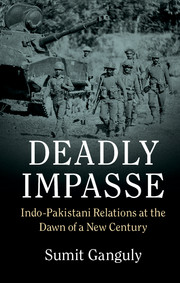Book contents
- Frontmatter
- Dedication
- Contents
- List of maps
- Preface and acknowledgments
- List of abbreviations
- 1 The rivalry revisited
- 2 Kargil and after
- 3 The troubled decade in Kashmir
- 4 The road to Operation Parakram
- 5 The composite dialogue and beyond
- 6 An extension of the rivalry
- 7 Policy implications
- In lieu of an epilogue
- Appendices
- References
- Index
2 - Kargil and after
Published online by Cambridge University Press: 05 March 2016
- Frontmatter
- Dedication
- Contents
- List of maps
- Preface and acknowledgments
- List of abbreviations
- 1 The rivalry revisited
- 2 Kargil and after
- 3 The troubled decade in Kashmir
- 4 The road to Operation Parakram
- 5 The composite dialogue and beyond
- 6 An extension of the rivalry
- 7 Policy implications
- In lieu of an epilogue
- Appendices
- References
- Index
Summary
THE KARGIL WAR AND AFTER
In the early hours of May 5, 1999, an Indian Army patrol from the 121st Brigade was sent out on a routine reconnaissance mission in the Kaksar region along the LoC in Kashmir. This area, in turn, is located within the region of Kargil, a particularly forbidding and unforgiving stretch of territory located within the district of Ladakh in the Indian-controlled portion of the state of Jammu and Kashmir. The mountainous peaks in this region range from 16,000 to 18,000 feet.
When the patrol failed to return, the commanders of the brigade enhanced their reconnaissance of the area. To their shock and dismay they discovered that there were about 100 intruders along various mountain peaks near Kargil. Initially they concluded that they possessed sufficient capabilities to dislodge the infiltrators. However, by mid-May they had dramatically altered their initial estimate when they concluded that as many as 800 intruders were in the area. Worse still, toward the end of the month they concluded that as many as 70 positions across the LoC had been breached.
Over the next several months India's armed forces had to mount a substantial air and ground counteroffensive to dislodge the invaders. In fact, this was the first occasion on which the IAF carried out military operations against Pakistani forces since the Indo-Pakistani war in 1971. The fighting did not conclude until the end of July despite a gradual withdrawal of hostile forces from about mid-July. The end of these military operations effectively concluded the fourth Indo-Pakistan conflict and the third one over the disputed state of Jammu and Kashmir.
The Kargil incursions had come in the aftermath of what Indian policy-makers had believed was a highly successful summit in Lahore, the capital of the Pakistani Punjab in February 1999. Prime Minister Atal Behari Vajpayee of India has chosen to initiate a dialogue with Pakistan in the wake of the global outcry following the Indian and Pakistani nuclear tests of 1998. The occasion chosen for his visit was the launch of a new bus service linking Lahore with the Indian city of Amritsar.
In Lahore he had worked out a series of nuclear confidence building measures (CBMs) with his counterpart, Prime Minister Nawaz Sharif of Pakistan, based upon months of prior preparation. These nuclear CBMs were significant.
- Type
- Chapter
- Information
- Deadly ImpasseIndo-Pakistani Relations at the Dawn of a New Century, pp. 31 - 52Publisher: Cambridge University PressPrint publication year: 2016



